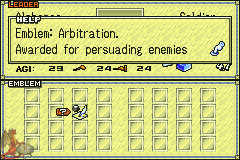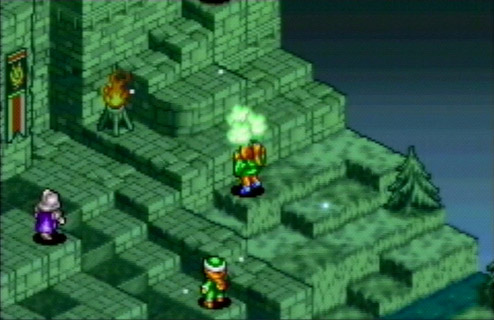 |
Tactics Ogre: The Knight of Lodis - Review |
 |
Let Us Cling to Atlus
By: Michael Beckett
| Review Breakdown |
| Battle System |
7 |
| Interface |
8 |
| Music/Sound |
5 |
| Originality |
5 |
| Plot |
8 |
| Localization |
9 |
| Replay Value |
8 |
| Visuals |
8 |
| Difficulty |
Easy to Average |
| Time to Complete |
25-40 hours
|
|
| Overall |
 |
| Criteria
|
Prequel to one of the most sought after games in RPG history, Tactics Ogre: The Knight of Lodis has some big shoes to fill. Its PlayStation compatriot, TO: Let us Cling Together, gained notoriety as one of the hardest games to locate on top of being a solid TRPG. Knight of Lodis isn't quite the game Let Us Cling Together was, but that makes it by no stretch of the imagination a bad game.
Combat is handled pretty much the same way every tactical RPG has handled combat since the genre's inception; a grid on which a selection of characters -yours and your opponent's - take turns at moves offensive and defensive in a setup reminiscient of a board game. Tactics Ogre makes a few modifications tothis basic formula, as all good TRPGs should, leaving the system a good deal better than when it was found. Combat in TO: TKoL is fast, engaging and even a little tricky at times. It's a good thing the combat system is this good, because combat is always central to TRPGs.
Menu and control play similarly important roles; if you can't control or customize or even view your character with a minimum of fuss, then, well, your problems are just beginning. Luckily, Tactics Ogre has none of these problems; there are a wide range of customizability options, and menus and control are all about as intuitive as can be. Still, in the great scheme of RPGs, interface is a largely invisible facet, or at least it is when it's working properly. Moving on...

|
| Emblems are awarded depending on your actions in battle.
|
|
Sound is almost always something of a letdown on the GBA. It's small speaker and limited sound capability usually leaves a bit of scratchiness in even the best tunes. Tactics Ogre's sound isn't bad, but isn't great. Combat music isn't bad, but is highly repetitive; in fact I have yet to see a TRPG have music which is not repetitive. It's just the length of the battles that do it, I think. In a twenty minute battle, even a three to five minute loop gets dull. Some of the themes during story sequences make a valiant attempt towards something more interesting, but in short, you won't be missing anything by turning the speaker off and putting some headphones on.
Another problem, besides repetitive music, that most TRPGs have is low originality. They all share such a similar common factor - the combat system - that without real effort, a TRPG you are making can very easily look like something already on the market. TO: TKoL doesn't stand out on the originality factor, but niether does it sink into the quagmire of mediocrity. Knight of Lodis stands firmly in the middle.
Plot, however, is where Tactics Ogre shines. What begins as a journey to a nearby island to help the oppressed and threatened turns into a battle not only for the survival of the human race, but also a struggle between friends for the birth of a new nation. Tactics Ogre's plot is branching, but playing through it, you'd never guess. Story elements fit together smoothly and without holes, no matter which path you take. The choices you make will alter the outcome of the story greatly; helping Cybil prevents you from helping Rictor, and so on. Also, whether your characters survive the battles or not also alter the story; if Ivanna dies in battle, later plot elements that would have included her obviously can't, since she's dead. So the story adapts. It's very impressive watching Alphonse's tale react to the decisions you make as him. The tale is well told and translated; a commendable job all around.
The other aspect of a game's story, the localization, obviously had some care taken in it. Character's speech unfolds smoothly and without those little confusing arpeggios that sometimes occur when something is translated directly from Japanese to English. A fine job.

|
| Mom used to say, "Never eat green snow or acid bursts." |
|
Replay value is quite high on this game; with huge amounts of choices in spells, weapons, characters and the classes they progress through, a limited weapon creation scheme and a plot that branches like a mangrove on crack, players will need at least three times through the game to see every ending, to say nothing of actually seeing everything TO: TKoL has to offer. Tactics Ogre's sheer replay value alone makes it a worthwhile purchase.
While Tactics Ogre's visuals don't hold a candle to the current visual champ, Golden Sun, they are not by any stretch of the imagination bad. They are a bit more cartoonish, a bit more anime than Golden Sun, but it works. The backgrounds, particularly the story backdrops, are highly detailed, practically works of art in and of them. There are no cinemas - I'd like to see someone try a cinema on the GBA - but the game is more than capable of producing story sequences with no hitch.
Difficulty can depend on the choices made throughout the game, but for the most part TO: TKoL is an easy game, aside from one or two battles. The shortest route to Ostorea Castle and on through Chapter 4 will take about 25 to 30 hours, while a complete run-through can take upwards of 40 hours.
Tactics Ogre: Knight of Lodis gets my recommendation for purchase for several reasons; first and foremost, it's wonderful plot that raises some intriguing questions about the relationship between angels, humans and God. Secondly, it's branching nonlinear plot, and third, the massive amount of pleasure derived from smashing a dragon's head in with Atropos. One has to get one's enjoyment somehow, after all.
|










